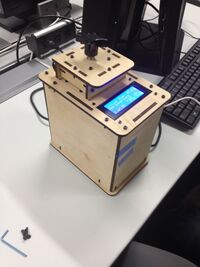BME100 f2013:W900 Group6 L4
| Home People Lab Write-Up 1 | Lab Write-Up 2 | Lab Write-Up 3 Lab Write-Up 4 | Lab Write-Up 5 | Lab Write-Up 6 Course Logistics For Instructors Photos Wiki Editing Help | |||||||||
|
OUR TEAMLAB 1 WRITE-UPInitial Machine TestingDisplayed above is a photo of an Open PCR Machine, which is a device that executes polymerase chain reactions in order to amplify a specific DNA strand. In order to amplify DNA, the Open PCR Machine creates an environment that ranges in extreme temperatures (from as little as 4 degrees Celsius to a maximum of 95 degrees Celsius). Several cycles of heating and cooling allows the DNA strands to split so that the enzyme Polymerase can create a complementary strand from the DNA template. The Open PCR Machine connects to a computer via a USB cable so that the Open PCR program can dictate the restrictions for the run. The various components (heating lid, core, and supply fan) work together to create the necessary environment, and the circuit board relays the information to the LCD light so that the experimenter can view the current state of the Open PCR Machine. Experimenting With the Connections When Part Three(LCD Screen) is unplugged from Part Six(Circut Board) it disconnects the LCD screen removing the power from it. When We Unplug the white wire that connects Part Six(Circut Board) to Part Two(Heating Block) the LCD screen shows a drop in temperature from 25.1 Degrees Celsius to 40 Degrees Celsius Test Run The Initial Test Run was done on October 23, 2013 in the Open PCR lab at 9:56. We began by installing the appropriate software on to the computer, the software for the Open PCR is simple to use and fairly easy to understand. There aren't many things wrong with the device other than minor details, such as the device having really small nuts and bolts making them easy to lose, the device takes very long to complete the cycles as well it would take about 2 hours to complete 35 cycles so if there was any way to shorten that time it would be great. Also the bolt on top to tighten the heating lid should be something different or make it easier to see the tubes so that one can see if the lid is too tight or loose, but other than minor details the device runs fine we had no other problems with it. We ended our experiment at 11:04 and completed 21 Cycles
ProtocolsThermal Cycler Program
PCR Reaction Mix Within the mix there is Taq DNA polymerase, MgCl2, and dNTP’s.
Each mix contains different DNA templates. Thus, all tubes will have the same forward primer (which means they will match the top strand sequence) and reverse primer (which means they will match the bottom strand sequence).
1) The answers for the PCR Reaction mix and DNA/Primer mix was found in "Section 2:Protocol Planning" under the section "Materials for Next Week" bullet points 1 and 2.
Research and DevelopmentPCR - The Underlying Technology Thermal Cycling Steps- The initial step of holding the temperature at 95°C activates the DNA polymerase through heat. During the denaturation step the two DNA strands are broken apart due to the high temperature. Next, the annealing process allows the primers to bond to each individual strand. The extending process then allows the DNA polymerase to synthesize complementary DNA strands from the primers. The final step of holding the temperature at 72°C allows additional time to ensure each strand of DNA is completely extended. The final hold at 4°C provides a short-term storage of the DNA samples. Nucleotide Bonding- Each of the four nucleotide bases, Adenine, Thymine, Cytosine and Guanine, are paired to one other specific base due to the hydrogen bonds. These four bases, commonly referred to as A, T, C, G, respecitvely, act as building blocks for DNA strands. The Adenine is always paired to the Thymine. Then the Cytosine is always paired with the Guanine.
| |||||||||






